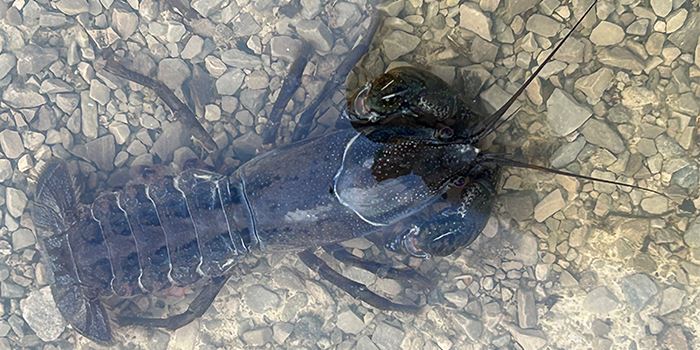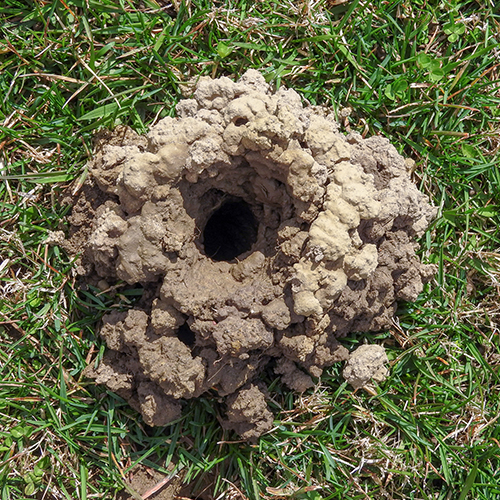Subterranean Architects

By Karen Menard
Like multi-appendaged mini-dozers, some species of mudbugs or “crayfish” as they are commonly called, spend much of their life in the dark, industriously pushing dirt around. And, life can be busiest for the ones known as our primary burrowers like the digger crayfish (Creaserinus fodiens), pictured. These animals can best be described as “master diggers,” excavating amazing, deep (3 to 6 feet) burrows down to groundwater that include simple, single chambered designs and others complete with double entrances leading to an impressive network of elongated chambers.
Additionally, there are species like the invasive rusty crayfish (Faxonius rusticus) in northwest Ohio that are simply referred to as “stream dwellers.” They mainly hang out under the sides of rocks submerged in moving streams or lakes. Other Ohio species are somewhat flexible in their habits and serve in both roles—as burrowers and stream dwellers.
Last week, after the torrential rains, I ventured out to Fallen Timbers Battlefield to look for crayfish. On this momentous occasion, digger crayfish were out of their burrows under the setting sun, swimming, floating and feeding over parts of the flooded trail system. Many were females with their young in tow, attached to swimmerets underneath the tail (see video). This species is typically the first to show itself in the spring.
The realization occurred to me, as many of these cryptic animals presented themselves that day, there were many more than I would have ever known. Keep in mind, even under the radar, crayfish are still important links in the wetland food chain both as predators and prey. They are considered a “keystone” species in their habitats and fill an important role as a popular food source in different stages of their lives for many types of mammals, fish, and birds. As carnivores and detritivores themselves, (feeding on decomposing matter), insects, small fish, worms, plants, fungi, and protozoans, encompass many of their preferred food items.
Empty burrows, especially along streambanks, are often sought after by other small mammals, water snakes, wasps, salamanders, and the rare, Hine’s emerald dragonfly for refuge, breeding and cooling off. Some burrows even have chimney toppers (see photo) and some do not, depending on the species.
Burrows crowned with a chimney are crafted by tireless, clawed architects with a critical goal in mind—to more efficiently improve the water and airflow/ventilation of their burrows. This carefully engineered vent-like structure represents an underworld conduit to the covert, cavernous life of a burrowing crayfish. A mud portal of sorts, it quickly and efficiently establishes an important connection between both terrestrial and aquatic worlds via one very skilled crustacean—the crayfish.
Did You Know?
There are about 22 crayfish species that reside in Ohio. Crayfish can amazingly re-grow broken claws and limbs.
---
Video: Female Digger Crayfish with young by Karen Menard
Photos: (Top) Digger Crayfish by Karen Menard; Primary burrower crayfish chimney, stock photo.
